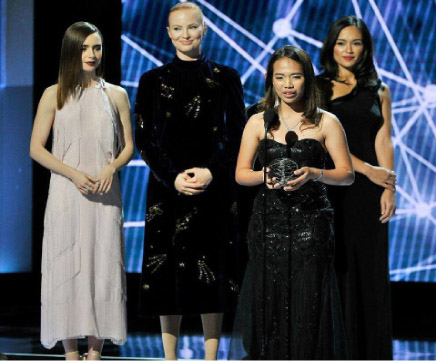
TACLOBAN CITY– For explaining a complex science principle into a relatively simple way which could be understood by ordinary people, Hillary Diane Andales won a worldwide competition.
The Grade 12 student of the Philippine Science High School (PSHS) in Palo, Leyte, the 18-year old native of Abuyog town was declared as this year’s winner of the Breakthrough Junior Challenge Prize.
By besting 11,000 entries from 178 countries, Andales received $250,000(P12.5 million) as her prize, of which $100,000 worth of a state-of-the-art science laboratory will go to her school and $50,000 for her teacher, Xavier Francis de los Reyes, who inspired her in making the video.
Andales personally received her award last December 3 as she was flown to the United States for the awarding at National Aeronautics and Space Administration’s Ames Research Center, California.
The Breakthrough Junior Challenge, now on its third year, is an annual global competition meant to inspire creative thinking about science among the young aged 13 to 18.
The Breakthrough Junior Challenge was founded by Facebook founder Mark Zuckerberg and his wife, Priscilla Chan; Yuri and Julia Milner, and Sergey Brin and Anne Wojcicki.
Contestants were required to submit original videos about three minutes long that would “bring to life a concept or theory in the life sciences, physics or mathematics.”
The entries were judged on the students’ ability to explain complex scientific ideas “in engaging, illuminating, and imaginative ways.”
In Andales’ case, the teenager used animation in explaining the theory of Relativity and Equivalence of Reference Frames.
“Basically, I explained in my video that what we observe is always relative to us, relative to our perspective, or relative to our reference frame. So what we see as red might look blue to another observer. And even if you disagree on the color, technically, you are both right because your observations are relative. Neither of you is wrong,” she explained.
The competition kicked off last September 1. She didn’t make it as the top scorer in the online competition, but made it to the finals as Asia’s regional representative and later, was declared the winner.
This was Andales’ second time in the competition.
Last year, her video won top popular vote after getting with more than 300,000 views.
While she automatically qualified as a finalist, her video failed to snag the grand prize.
But as the winner of the top popular vote, her school received DNA molecular-biology laboratory worth $100,000 which was turned over last month by Cold Spring Harbor Laboratory.
Andales said she always looked up to two kinds of stars –one that illuminated the skies and the other, inspiring her with their genius.
She said she hoped that her award would also inspire young people like her “to look up and be scientists themselves, the stars, we should look up to.”
In an online message, Rey Garnace, director of PSHS EV, said that while he was euphoric of Andales’ victory, he was not surprised.
“Andales has been our school pride. She has imbibed the vision of the school to have a passion for excellence, pursuit for truth, and service to the nation,” he said.
With her prize, Andales said that she is now contemplating of studying in a prestigious school abroad that could help her improve and enhance her knowledge in Physics.
Before winning the scholarship prize, Andales said that she was eyeing big universities in Manila.
“For me to maximize that huge amount of money, I think it would be better if I would study abroad so I could really maximize what I’ve learned and for me to give back to the Filipino people. I am eyeing universities in the US so I could study in a good Physics program,” Andales said.
Among the universities abroad she’s aiming are Harvard University; Massachusetts Institute of Technology, both in Massachusetts, USA and Princeton University in New Jersey, USA. (VICKY C. ARNAIZ with report ROEL T. AMAZONA)



